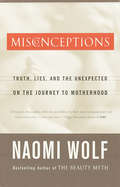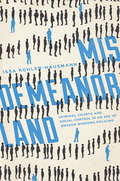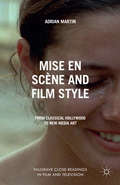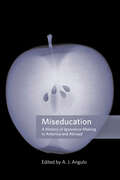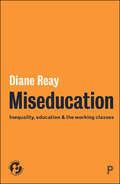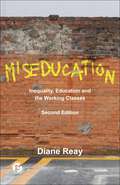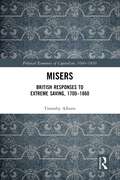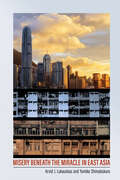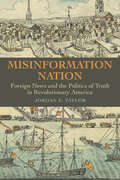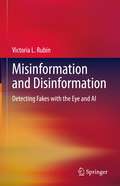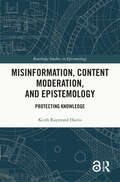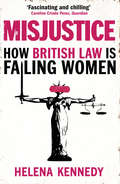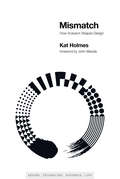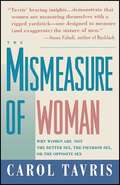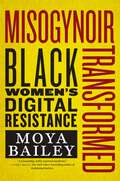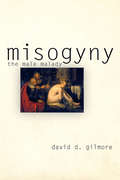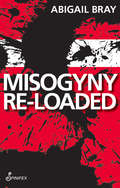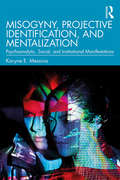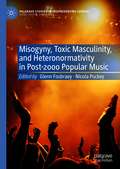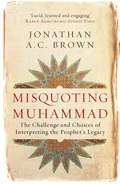- Table View
- List View
Mischief, Morality and Mobs: Essays in Honour of Geoffrey Pearson (Routledge Advances in Ethnography)
by Dick HobbsGeoffrey Pearson, who died in 2013, was one of the outstanding social scientists of the post second world war era. His work spanned social work, social theory, social history, criminology and sociology. In particular, his work has had a huge impact upon studies of youth, youth culture and drugs. This collection is made up of contributions from scholars producing empirical work on some of the key areas upon which Geoff Pearson established his reputation. All of the writers in this collection have been profoundly influenced by his scholarship. This collection focuses on urban ethnography, race and ethnicity, youth, and drugs. It includes chapters on: women working in male boxing gyms; understanding the English Defence League; Black male adults as an ignored societal group; drug markets and ethnography; and sex, drugs and kids in care. The result is a cutting edge collection that takes readers into social worlds that are difficult to access, complex, yet utterly normal. Overall this is an exciting and fittingly challenging tribute to one of the UKs most important scholars. This volume will appeal to scholars and students of criminology, sociology, social history and research methodology – in particular ethnography.
Misconceptions: Truth, Lies, and the Unexpected on the Journey to Motherhood
by Naomi WolfIn Misconceptions, bestselling author Naomi Wolf she demythologizes motherhood and reveals the dangers of common assumptions about childbirth. With uncompromising honesty she describes how hormones eroded her sense of independence, ultrasounds tested her commitment to abortion rights, and the keepers of the OB/GYN establishment lacked compassion. The weeks after her first daughter&’s birth taught her how society, employers, and even husbands can manipulate new mothers. She had bewildering post partum depression, but learned that a surprisingly high percentage of women experience it. Wolf&’s courageous willingness to talk about the unexpected difficulties of childbirth will help every woman become a more knowledgeable planner of her pregnancy and better prepare her for the challenges of balancing a career, freedom, and a growing family. Invaluable in its advice to parents, Misconceptions speaks to anyone connected–personally, medically, or professionally–to a new mother.
Misdemeanorland: Criminal Courts and Social Control in an Age of Broken Windows Policing
by Issa Kohler-HausmannAn in-depth look at the consequences of New York City’s dramatically expanded policing of low-level offensesFelony conviction and mass incarceration attract considerable media attention these days, yet the most common criminal-justice encounters are for misdemeanors, not felonies, and the most common outcome is not prison. In the early 1990s, New York City launched an initiative under the banner of Broken Windows policing to dramatically expand enforcement against low-level offenses. Misdemeanorland is the first book to document the fates of the hundreds of thousands of people hauled into lower criminal courts as part of this policing experiment.Drawing on three years of fieldwork inside and outside of the courtroom, in-depth interviews, and analysis of trends in arrests and dispositions of misdemeanors going back three decades, Issa Kohler-Hausmann argues that lower courts have largely abandoned the adjudicative model of criminal law administration in which questions of factual guilt and legal punishment drive case outcomes. Due to the sheer volume of arrests, lower courts have adopted a managerial model--and the implications are troubling. Kohler-Hausmann shows how significant volumes of people are marked, tested, and subjected to surveillance and control even though about half the cases result in some form of legal dismissal. She describes in harrowing detail how the reach of America's penal state extends well beyond the shocking numbers of people incarcerated in prisons or stigmatized by a felony conviction.Revealing and innovative, Misdemeanorland shows how the lower reaches of our criminal justice system operate as a form of social control and surveillance, often without adjudicating cases or imposing formal punishment.
Mise en Scène and Film Style: From Classical Hollywood to New Media Art (Palgrave Close Readings in Film and Television)
by A. MartinStyles of filmmaking have changed greatly from classical Hollywood through to our digital era. So, too, have the ways in which film critics and scholars have analysed these transformations in film style. This book explores two central style concepts, mise en scène and dispositif, to illuminate a wide range of film and new media examples.
Miseducation: A History of Ignorance-Making in America and Abroad
by A. J. AnguloA provocative collection that explores how intentional ignorance seeps into formal education.Honorable Mention for the PROSE Education Theory Award of the Association of American PublishersIgnorance, or the study of ignorance, is having a moment. Ignorance plays a powerful role in shaping public opinion, channeling our politics, and even directing scholarly research. The first collection of essays to grapple with the historical interplay between education and ignorance, Miseducation finds ignorance—and its social production through naïveté, passivity, and active agency—at the center of many pivotal historical developments. Ignorance allowed Americans to maintain the institution of slavery, Nazis to promote ideas of race that fomented genocide in the 1930s, and tobacco companies to downplay the dangers of cigarettes. Today, ignorance enables some to deny the fossil record and others to ignore climate science. A. J. Angulo brings together seventeen experts from across the scholarly spectrum to explore how intentional ignorance seeps into formal education. Each chapter identifies education as a critical site for advancing our still-limited understanding of what exactly ignorance is, where it comes from, and how it is diffused, maintained, and regulated in society.Miseducation also challenges the notion that schools are, ideally, unimpeachable sites of knowledge production, access, and equity. By investigating how laws, myths, national aspirations, and global relations have recast and, at times, distorted the key purposes of education, this pathbreaking book sheds light on the role of ignorance in shaping ideas, public opinion, and policy.
Miseducation: Inequality, Education and the Working Classes (21st Century Standpoints)
by Diane ReayIn this book Diane Reay, herself working class turned Cambridge professor, brings Brian Jackson and Dennis Marsden’s pioneering Education and the Working Class from 1962 up to date for the 21st century.Drawing on over 500 interviews, the book, part of the 21st Century Standpoints series published in association with the British Sociological Association, includes rich, vivid stories from working class children and young people. It looks at class identity, the inadequate sticking plaster of social mobility, and the effects of wider economic and social class relationships on working class educational experiences.The book addresses the urgent question of why the working classes are still faring so much worse than the upper and middle classes in education. It reveals how we have ended up with an educational system that still educates the different social classes in fundamentally different ways, and vitally – what we can do to achieve a fairer system.
Miseducation: Inequality, Education and the Working Classes (21st Century Standpoints)
by Diane ReayEducation is supposed to level the playing field, and yet for many working-class children inequalities in the classroom in fact deepen the divide. Students from disadvantaged backgrounds are almost four times more likely to be excluded from school than their wealthier peers and many are struggling in an educational environment increasingly concerned with discipline. In this substantially revised and updated edition of her bestselling book, Diane Reay – herself working class turned Cambridge professor – investigates why we educate social classes so differently. Drawing on extensive interviews with working class children and young people, Miseducation offers a sharp critique of how class identity, social mobility, and entrenched inequalities shape educational outcomes. It also examines the increasing focus on control and discipline in UK schools and charts the impact of policies like academies on working-class students. In a new chapter, Reay draws lessons from educational systems around the world, while a second presents clear recommendations for creating a system that supports every child’s potential. Insightful and thought-provoking, this book is essential reading for anyone invested in the future of education and social equity.
Misers: British Responses to Extreme Saving, 1700–1860 (Political Economies of Capitalism, 1600-1850)
by Timothy AlbornThis volume uses the extreme case of misers to examine interlocking categories that undergirded the emergence of modern British society, including new perspectives on charity, morality, and marriage; new representations of passion and sympathy; and new modes of saving, spending, and investment. Misers surveys this class of people—as invented and interpreted in sermons, poems, novels, and plays; analyzed by economists and philosophers; and profiled in obituaries and biographies—to explore how British attitudes about saving money shifted between 1700 and 1860. As opposed to the century before, the nineteenth century witnessed a new appreciation for misers, as economists credited them with adding to the nation's stock of capital and novelists newly imagined their capacity to empathize with fellow human beings. These characters shared the spotlight with real people who posthumously donned that label, populating into a cottage industry of miser biographies by the 1850s. By the time A Christmas Carol appeared in 1843, many Victorians had come to embrace misers as links that connected one generation’s extreme saving with the next generation’s virtuous spending. With a broad chronological period, this volume is useful for students and scholars interested in representation of misers in eighteenth- and nineteenth-century Britain.
Misery beneath the Miracle in East Asia (Studies of the Weatherhead East Asian Institute, Columbia University)
by Arvid J. Lukauskas Yumiko ShimabukuroMisery beneath the Miracle in East Asia challenges prevailing views of the East Asian economic miracle. Existing scholarship has overlooked the severity, persistence, and harmful consequences of the social-welfare crises affecting the region. Arvid J. Lukauskas and Yumiko Shimabukuro fill this gap and put a major asterisk on East Asia's economic record. Combining big-picture analysis, abundant data, a dynamic interdisciplinary framework, and powerful human stories, they shed light on the social ills that governments have failed to address adequately, including low wages, child abuse, elderly poverty, and substandard housing. One of the major forces behind the multidimensional welfare crises is the region's productivist welfare strategy, which prioritizes economic growth while abandoning a robust social safety net, leaving the most vulnerable segments of society largely unprotected. Misery beneath the Miracle in East Asia brings the region into debates over the dangers of seeking growth at all costs that are currently embroiling the United States and other advanced industrialized countries.
Misinformation Nation: Foreign News and the Politics of Truth in Revolutionary America
by Jordan E. TaylorFundamentally reshapes our understanding of the causes of the American Revolution and the pivotal role foreign news and misinformation played in driving colonists to revolt."Fake news" is not new. Just like millions of Americans today, the revolutionaries of the eighteenth century worried that they were entering a "post-truth" era. Their fears, however, were not fixated on social media or clickbait, but rather on peoples' increasing reliance on reading news gathered from foreign newspapers. In Misinformation Nation, Jordan E. Taylor reveals how foreign news defined the boundaries of American politics and ultimately drove colonists to revolt against Britain and create a new nation.News was the lifeblood of early American politics, but newspaper printers had few reliable sources to report on events from abroad. Accounts of battles and beheadings, as well as declarations and constitutions, often arrived alongside contradictory intelligence. Though frequently false, the information that Americans encountered in newspapers, letters, and conversations framed their sense of reality, leading them to respond with protests, boycotts, violence, and the creation of new political institutions. Fearing that their enemies were spreading fake news, American colonists fought for control of the news media. As their basic perceptions of reality diverged, Loyalists separated from Patriots and, in the new nation created by the revolution, Republicans inhabited a political reality quite distinct from that of their Federalist rivals. The American Revolution was not only a political contest for liberty, equality, and independence (for white men, at least); it was also a contest to define certain accounts of reality to be truthful while defining others as false and dangerous. Misinformation Nation argues that we must also conceive of the American Revolution as a series of misperceptions, misunderstandings, and uninformed overreactions. In addition to making a striking and original argument about the founding of the United States, Misinformation Nation will be a valuable prehistory to our current political moment.
Misinformation and Disinformation: Detecting Fakes with the Eye and AI
by Victoria L. RubinThis book, geared towards both students and professionals, examines the synthesis of artificial intelligence (AI) and psychology in detecting mis-/disinformation in digital media content, and suggests practical means to intervene and curtail this current global ‘infodemic’. This interdisciplinary book explores technological, psychological, philosophical, and linguistic insights into the nature of truth and deception, trust and credibility, cognitive biases and logical fallacies and how, through AI and human intervention, content users can be alerted to the presence of deception. The author investigates how AI can mimic the procedures and know-hows of humans, showing how AI can help spot fakes and how AI tools can work to debunk rumors and fact-check. The book describes how AI detection systems work and how they fit with broader societal and individual concerns. Each chapter focuses attention on key concepts and their inter-connection. The first part of the book seeks theoretical footing to understand our interactions with new information and reviews relevant empirical findings in behavioral sciences. The second part is about applied knowledge. The author looks at several known practices that guard us against deception, and provides several real-world examples of manipulative persuasive techniques in advertising, political propaganda, and public relations. She provides links to the downloadable executable files to three AI applications (clickbait, satire, and falsehood detectors) via LiT.RL GitHub, an open access repository. The book is useful to students and professionals studying AI and media studies as well as library and information professionals.Examines how artificial intelligence (AI) and psychology can aid in detecting mis-/disinformation and the language of deceit in digital media content;Suggests practical computational means to intervene and curtail the global ‘infodemic’ of fake news;Presents how AI can sift, sort, and shuffle digital content, to reduce the amount of content needed to be reviewed by humans.
Misinformation and Mass Audiences
by Brian G. Southwell, Emily A. Thorson, and Laura ShebleLies and inaccurate information are as old as humanity, but never before have they been so easy to spread. Each moment of every day, the Internet and broadcast media purvey misinformation, either deliberately or accidentally, to a mass audience on subjects ranging from politics to consumer goods to science and medicine, among many others. Because misinformation now has the potential to affect behavior on a massive scale, it is urgently important to understand how it works and what can be done to mitigate its harmful effects. Misinformation and Mass Audiences brings together evidence and ideas from communication research, public health, psychology, political science, environmental studies, and information science to investigate what constitutes misinformation, how it spreads, and how best to counter it. The expert contributors cover such topics as whether and to what extent audiences consciously notice misinformation, the possibilities for audience deception, the ethics of satire in journalism and public affairs programming, the diffusion of rumors, the role of Internet search behavior, and the evolving efforts to counteract misinformation, such as fact-checking programs. The first comprehensive social science volume exploring the prevalence and consequences of, and remedies for, misinformation as a mass communication phenomenon, Misinformation and Mass Audiences will be a crucial resource for students and faculty researching misinformation, policymakers grappling with questions of regulation and prevention, and anyone concerned about this troubling, yet perhaps unavoidable, dimension of current media systems.
Misinformation, Content Moderation, and Epistemology: Protecting Knowledge (Routledge Studies in Epistemology)
by Keith Raymond HarrisThis book argues that misinformation poses a multifaceted threat to knowledge, while arguing that some forms of content moderation risk exacerbating these threats. It proposes alternative forms of content moderation that aim to address this complexity while enhancing human epistemic agency.The proliferation of fake news, false conspiracy theories, and other forms of misinformation on the internet and especially social media is widely recognized as a threat to individual knowledge and, consequently, to collective deliberation and democracy itself. This book argues that misinformation presents a three-pronged threat to knowledge. While researchers often focus on the role of misinformation in causing false beliefs, this deceptive potential of misinformation exists alongside the potential to suppress trust and to distort the perception of evidence. Recognizing the multifaceted nature of this threat is essential to the development of effective measures to mitigate the harms associated with misinformation. The book weaves together work in analytic epistemology with emerging empirical work in other disciplines to offer novel insights into the threats posed by misinformation. Additionally, it breaks new ground by systematically assessing different forms of content moderation from the perspective of epistemology.Misinformation, Content Moderation, and Epistemology will appeal to philosophers working in applied and social epistemology, as well as scholars and advanced students in disciplines such as communication studies, political science, and social psychology who are researching misinformation.The Introduction and Chapter 1 of this book are freely available as downloadable Open Access PDFs at http://www.taylorfrancis.com under a Creative Commons Attribution-Non Commercial-No Derivatives (CC-BY- NC- ND) 4.0 license.
Misjustice: How British Law is Failing Women
by Helena KennedyTwo women a week are killed by a spouse or partner. Every seven minutes a woman is raped. Now is the time for change.‘Fascinating and chilling’ Caroline Criado Perez, bestselling author of Invisible Women Helena Kennedy, one of our most eminent lawyers and defenders of human rights, examines the pressing new evidence that women are being discriminated against when it comes to the law. From the shocking lack of female judges to the scandal of female prisons and the double discrimination experienced by BAME women, Kennedy shows with force and fury that change for women must start at the heart of what makes society just. ‘An unflinching look at women in the justice system… an important book because it challenges acquiescence to everyday sexism and inspires change’ The Times
Miskawayh's Tahḏīb al-aḫlāq: Happiness, Justice and Friendship (Routledge Studies in Islamic Philosophy)
by Ufuk TopkaraThis book engages with the work of Miskawayh, a formative Islamic Philosopher in the 11th century, who is acknowledged as the founder of Islamic Moral Philosophy. Miskawayh’s The Refinement of Character (Tahḏīb al-Aḫlāq) draws from both ancient Greek philosophical tradition and Islamic thought, highlighting the concepts he integrated into what he argued to be the moral core of Islam. This book pursues a comparative study by analyzing and outlining the inherent philosophical concerns of the Aristotelian concepts of Happiness, Justice and Friendship, which are then brought into conversation with Miskawayh’s own concepualizations of them. While Tahḏīb al-Aḫlāq is deeply influenced by Aristotle’s ethics, Miskawayh employs not only a Platonizing interpretation of Aristotelian philosophy, but also incorporates traditions of Islamic thought. The study therefore concludes that Miskawayh is merely a transmitter of ancient Greek philosophy, as shown by both his critical survey of the material available to him and his own critical contributions. Essentially, Miskawayh attempted to harmonize philosophical and religious concepts of knowledge, demonstrating the interlinking of what are perceived as—at times detrimentally—incompatible positions. Ufuk Topkara illustrates how Aristotle’s Ethics are integrated, modified and at times adjusted to the broader narrative of Islamic thought and how Miskawayh’s discourse, albeit philosophical in nature, remains religious in its outlook. Providing clear insight into Miskawayh’s work, this book is ideal for students and scholars of Islamic Philosophy and Muslim Theology.
Mismatch: How Inclusion Shapes Design (Simplicity: Design, Technology, Business, Life)
by Kat HolmesHow inclusive methods can build elegant design solutions that work for all.Sometimes designed objects reject their users: a computer mouse that doesn't work for left-handed people, for example, or a touchscreen payment system that only works for people who read English phrases, have 20/20 vision, and use a credit card. Something as simple as color choices can render a product unusable for millions. These mismatches are the building blocks of exclusion. In Mismatch, Kat Holmes describes how design can lead to exclusion, and how design can also remedy exclusion. Inclusive design methods—designing objects with rather than for excluded users—can create elegant solutions that work well and benefit all.Holmes tells stories of pioneers of inclusive design, many of whom were drawn to work on inclusion because of their own experiences of exclusion. A gamer and designer who depends on voice recognition shows Holmes his “Wall of Exclusion,” which displays dozens of game controllers that require two hands to operate; an architect shares her firsthand knowledge of how design can fail communities, gleaned from growing up in Detroit's housing projects; an astronomer who began to lose her eyesight adapts a technique called “sonification” so she can “listen” to the stars.Designing for inclusion is not a feel-good sideline. Holmes shows how inclusion can be a source of innovation and growth, especially for digital technologies. It can be a catalyst for creativity and a boost for the bottom line as a customer base expands. And each time we remedy a mismatched interaction, we create an opportunity for more people to contribute to society in meaningful ways.
Mismeasure of Woman: Why Women are Not the Better Sex, the Inferior Sex, or the Opposite Sex
by Carol TavrisWhen "man is the measure of all things," woman is forever trying to measure up. In this enlightening book, Carol Tavris unmasks the widespread but invisible custom -- pervasive in the social sciences, medicine, law, and history -- of treating men as the normal standard, women as abnormal. Tavris expands our vision of normalcy by illuminating the similarities between women and men and showing that the real differences lie not in gender, but in power, resources, and life experiences. Winner of the American Association for Applied and Preventive Psychology's Distinguished Media Contribution Award
Misogynoir Transformed: Black Women’s Digital Resistance (Intersections #18)
by Moya BaileyWhere racism and sexism meet—an understanding of anti-Black misogynyWhen Moya Bailey first coined the term misogynoir, she defined it as the ways anti-Black and misogynistic representation shape broader ideas about Black women, particularly in visual culture and digital spaces. She had no idea that the term would go viral, touching a cultural nerve and quickly entering into the lexicon. Misogynoir now has its own Wikipedia page and hashtag, and has been featured on Comedy Central’s The Daily Show and CNN’s Cuomo Prime Time. In Misogynoir Transformed, Bailey delves into her groundbreaking concept, highlighting Black women’s digital resistance to anti-Black misogyny on YouTube, Facebook, Tumblr, and other platforms. At a time when Black women are depicted as more ugly, deficient, hypersexual, and unhealthy than their non-Black counterparts, Bailey explores how Black women have bravely used social-media platforms to confront misogynoir in a number of courageous—and, most importantly, effective—ways. Focusing on queer and trans Black women, she shows us the importance of carving out digital spaces, where communities are built around queer Black webshows and hashtags like #GirlsLikeUs. Bailey shows how Black women actively reimagine the world by engaging in powerful forms of digital resistance at a time when anti-Black misogyny is thriving on social media. A groundbreaking work, Misogynoir Transformed highlights Black women’s remarkable efforts to disrupt mainstream narratives, subvert negative stereotypes, and reclaim their lives.
Misogyny
by David D. Gilmore"Yes, women are the greatest evil Zeus has made, and men are bound to them hand and foot with impossible knots by God."--Semonides, seventh century B.C.Men put women on a pedestal to worship them from afar--and to take better aim at them for the purpose of derision. Why is this paradoxical response to women so widespread, so far-reaching, so all-pervasive? Misogyny, David D. Gilmore suggests, is best described as a male malady, as it has always been a characteristic shared by human societies throughout the world.Misogyny: The Male Malady is a comprehensive historical and anthropological survey of woman-hating that casts new light on this age-old bias. The turmoil of masculinity and the ugliness of misogyny have been well documented in different cultures, but Gilmore's synoptic approach identifies misogyny in a variety of human experiences outside of sex and marriage and makes a fresh and enlightening contribution toward understanding this phenomenon. Gilmore maintains that misogyny is so widespread and so pervasive among men that it must be at least partly psychogenic in origin, a result of identical experiences in the male developmental cycle, rather than caused by the environment alone.Presenting a wealth of compelling examples--from the jungles of New Guinea to the boardrooms of corporate America--Gilmore shows that misogynistic practices occur in hauntingly identical forms. He asserts that these deep and abiding male anxieties stem from unresolved conflicts between men's intense need for and dependence upon women and their equally intense fear of that dependence. However, misogyny, according to Gilmore, is also often supported and intensified by certain cultural realities, such as patrilineal social organization; kinship ideologies that favor fraternal solidarity over conjugal unity; chronic warfare, feuding, or other forms of intergroup violence; and religious orthodoxy or asceticism. Gilmore is in the end able to offer steps toward the discovery of antidotes to this irrational but global prejudice, providing an opportunity for a lasting cure to misogyny and its manifestations.
Misogyny Re-Loaded
by Abigail BrayBlending personal experience with rigorous study, this explosive manifesto rails against what it presents as the resurgent sexual fascism of the new world order. By exposing everything from the casual acceptance of snuff pornography in "gore" culture to the framing of rape as a punch line, Abigail Bray links the celebration of sexual sadism to the rise of an authoritarian culture of militarized violence. Arguing that a meaningful collective resistance has been undermined by the mass destruction of genuine social and economic security for ordinary women, Misogyny Re-loaded presents a scathing critique of a politically convenient, billionaire-friendly, mainstream brand of feminism. Drawing on a wide range of resources from popular culture, literature, economics, psychiatry, psychology, philosophy, and environmental science, this book offers a warning about the growing social and environmental threat of an out-of-control military industrial complex.
Misogyny as Hate Crime (Victims, Culture and Society)
by Irene Zempi Jo SmithMisogyny as Hate Crime explores the background, nature and consequences of misogyny as well as the legal framework and UK policy responses associated with misogyny as a form of hate crime. Taking an intersectional approach, the book looks at how experiences of misogyny may intersect with other forms of hate crime such as disablism, Islamophobia, antisemitism and transphobia. From the sexist and derogatory comments about women by former US President Donald Trump, to legislative changes in Chile and Peru making street harassment illegal, misogyny presents a challenge to scholars, practitioners, policy makers, and women globally. The increasing importance of the internet has seen misogyny move into these digital spaces but has also provided a platform for movements such as #MeToo and #TimesUp, highlighting the scale of sexual harassment and abuse. In 2016, Nottinghamshire Police in partnership with Nottingham Women’s Centre became the first force in England and Wales to record misogyny as a hate crime. Since then other police forces have introduced similar schemes to tackle misogyny. More recently, the Law Commission of England and Wales has undertaken a review of the legislation on hate crime and in their consultation paper of proposals for reform have suggested ‘adding sex or gender to the protected characteristics’. In March 2021, the Government announced that police forces in England and Wales will be required to record crimes motivated by hostility based on sex or gender from this autumn. The murder of Sarah Everard has been a ‘watershed moment’ in the Government’s response to violence against women. Sarah Everard’s kidnap and murder who went missing while walking home from a friend’s flat in South London on 3 March 2021, ignited a national conversation about violence against women. Against this background, the book speaks both to the proposed reforms of the hate crime legislation around misogyny, and the broader issues around experiences of and legal responses to misogyny. It showcases the work of leading scholars in this area alongside that of activists and practitioners, whose work has been invaluable in opening up public discussion on misogynistic hate crime and encouraging wider social change. In recognising the intersections of different forms of prejudice, the book provides an innovative contribution to these ‘hate debates’, highlighting the complexities of creating separate strands of hate crime. Providing a comprehensive understanding of the debates around inclusion of misogyny as a form of hate crime, this ground-breaking book will be of great interest to students, scholars and activists interested in gender, hate crime, feminism, criminology, law, policing and sociology.
Misogyny, Projective Identification, and Mentalization: Psychoanalytic, Social, and Institutional Manifestations
by Karyne E. MessinaMisogyny, Projective Identification, and Mentalization looks at how the psychoanalytic concepts of projective identification and mentalization may explain the construction of society and how they have enabled misogyny to be expressed in social, political, and institutional settings. Karyne E. Messina explores how misogyny has affected the perception and treatment of women through analysis of a range of examples of individual women and groups. The first part explores projective identification as a mechanism for the suppression of women, looking at the origins of the concept in psychoanalysis and its expansion. The author examines the story of Clara Thompson as an example, arguing that her virtual disappearance from the history of psychiatry and psychoanalysis itself is a telling example of this process at work. The second part of the book uses four examples of individuals, including the recent election loss by Hillary Clinton in 2016, to show that projective identification can (particularly in political and cultural settings) overtake and motivate groups as well as individuals, and lead to violence, atrocity, humiliation, and dismissal of and against women. Part three then features case studies of four groups of women from the 20th century, including victims of the 1994 Rwandan genocide, showing how projective identification against groups has occurred. With specific reference to the erasure of women’s contributions in society, both individually and collectively, and the trauma that arises from the many effects of regarding women as a group as "less" or "other", this is a book which sets a new agenda for understanding how misogyny is expressed socially. Misogyny, Projective Identification, and Mentalization will be of interest to psychoanalysts and psychoanalytic psychotherapists as well as scholars of politics, gender, and cultural studies.
Misogyny, Toxic Masculinity, and Heteronormativity in Post-2000 Popular Music (Palgrave Studies in (Re)Presenting Gender)
by Glenn Fosbraey Nicola PuckeyThis book presents chapters that have been brought together to consider the multitude of ways that post-2000 popular music impacts on our cultures and experiences. The focus is on misogyny, toxic masculinity, and heteronormativity. The authors of the chapters consider these three concepts in a wide range of popular music styles and genres; they analyse and evaluate how the concepts are maintained and normalized, challenged, and rejected. The interconnected nature of these concepts is also woven throughout the book. The book also seeks to expand the idea of popular music as understood by many in the West to include popular music genres from outside western Europe and North America that are often ignored (for example, Bollywood and Italian hip hop), and to bring in music genres that are inarguably popular, but also sit under other labels such as rap, metal, and punk.
Misquoting Muhammad: The Challenge And Choices Of Interpreting The Prophet's Legacy (Islam in the Twenty-First Century)
by Jonathan A. C. BrownFew things provoke controversy in the modern world like the religion brought by Muhammad. Modern media are replete with alarm over jihad, underage marriage and the threat of amputation or stoning under Shariah law. Sometimes rumor, sometimes based in fact and often misunderstood, the tenets of Islamic law and dogma were not set in the religion’s founding moments. They were developed over centuries by the clerical class of Muslim scholars. Misquoting Muhammad takes the reader back in time through Islamic civilization and traces how and why such controversies developed, offering an inside view into how key and controversial aspects of Islam took shape. From the protests of the Arab Spring to Istanbul at the fall of the Ottoman Empire, and from the ochre red walls of Delhi’s great mosques to the trade routes of Islam’s Indian Ocean world, Misquoting Muhammad lays out how Muslim intellectuals have sought to balance reason and revelation, weigh science and religion, and negotiate the eternal truths of scripture amid shifting values.


